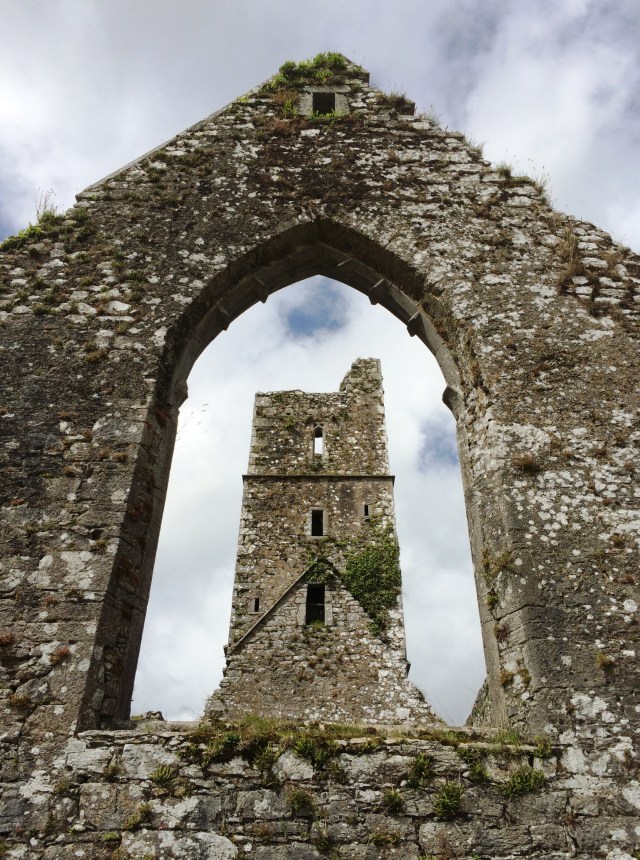
In Ireland the term Abbey is often applied to any mediaeval religious ruin. Thus the friary at Kilcrea, County Cork is often called an abbey, even though it was established by the Observant Franciscans. On the other hand, the site – or at least a spot close to it – was originally settled by St Cere or Cyra. An early Irish Christian, she founded a nunnery here and it is from her that the friary’s name derives: Cill Chre (Cell of Cyra) which was anglicized to Kilcrea. The Franciscan friars only arrived in 1465 at the request of Cormac Láidir Mór, Lord of Muskerry (as this part of Cork was anciently called). A branch of the great MacCarthy Mor dynasty, this family later became Viscounts Muskerry and Earls of Clancarty before being dispossessed of their lands and attainted in the late 17th century. But they were at the height of their power when Kilcrea Friary was established, as is testified by the nearby castle built around the same time: Cormac Láidir Mór was also responsible for building the castles at Blarney and Dripsey (otherwise known as Carrignamuck). However in 1494 he was killed by his brother and nephew at the latter location, and was interred in the centre of Kilcrea’s choir.




Kilcrea friary was dedicated to St Brigid of Kildare and for more than a century appears to have thrived under MacCarthy patronage even after religious houses were officially suppressed in 1541. During the Elizabethan era circumstances changed, especially following the appointment of John Perrot as President of Munster in 1570. During his tenure in office Thomas O’Herlihy, Roman Catholic Bishop of Ross was imprisoned in the Tower of London and only released after almost four years on the surety of Cormac MacDiarmuid MacCarthy, then Lord of Muskerry: following O’Herlihy’s death in 1579 he too was buried at Kilcrea. Five years later the friary was sacked by English soldiers and thereafter it was subject to several assaults and changes of ownership. In Joseph Stirling Coyne and Nathaniel Willis’s The Scenery and Antiquities of Ireland (1841), it is written that Kilcrea Friary’s ‘principal interest arises from the melancholy contemplation of the gloomy and neglected aisles, where the dust of prince and peasant lie mingled in undistinguishable contusion beneath the ruinous tombstones, which are scattered over every portion of the church and convent. Most of these stones bear the names of the old families and septs of the district: McCarthy, M’Swiney, and Barrett, are the most numerous. There are doubtless many interesting monuments to be found here; but the accumulation of mould, bones, and other relics of mortality within the precincts of the ruins, renders it impossible to discover them without considerable labour…’




One of the monuments at Kilcrea Friary so summarily dismissed by Stirling Coyne and Willis is the tomb of Art Ó Laoghaire or O’Leary, whose widow Eibhlín Dubh Ní Chonaill (an aunt of Daniel O’Connell) wrote a famous lament following her husband’s death in 1773 at the age of just twenty-six. A former captain in the Huzzars Regiment of the Austrian Imperial army O’Leary had, following his return to Ireland six years earlier, become involved in a dispute with a neighbour, Abraham Morris, High Sheriff of County Cork. Following his refusal to sell a horse to Morris for £5 (as Roman Catholics were obliged to do under the Penal Laws of the time) O’Leary was declared an outlaw and on being discovered by Morris and a group of men was shot dead at Carrignanimma: Morris would die two years later, his life shortened, it was believed, after he had in turn been shot by O’Leary’s brother. Meanwhile Eibhlín Dubh Ní Chonaill composed her remarkable Caoineadh, a 390-line lament in which she mourned her husband’s death and called for revenge on his killers; for long remaining part of the country’s oral tradition, the words were only written down many years later. Art O’Leary was initially buried elsewhere before being interred in Kilcrea Friary where his tomb can be seen with an inscription believed to have been also composed by his widow: ‘Lo Arthur Leary, Generous, Handsome, Brave/Slain in His Bloom lies in this Humble Grave.’
After passing through diverse hands, since 1892 Kilcrea Friary has been in the care of the Office of Public Works.

And what else can be done there to help preserve the site?
A horse valued at £5.00? This must have been a substantial sum in 1773. I wonder what a labourer earned per year in 1773? Many thanks for such interesting posts.
Michael
Congratulations on such beautiful photographs. The Jesuit Poet Peter Levi said that the Lament for Arthur O’Leary was perhaps the greatest poem composed in the archipelago in the eighteenth century.
Thank you for your kind words. The Lament for Arthur O’Leary is an astonishing piece of work, all the more so for being improvised and spoken: as mentioned, it was not written down until many years later and testifies to the abiding strength of the Irish oral tradition.
Great presentation, both images and words. Love the arbour walk in the first image. Maybe the odd McCarthy had a hand in the friary construction as well 🙂
I have a number of relatives buried here at Kilcrea. A place near and dear to me!! Many thank for an awesome website.
I can see their graves in the 4th photo.